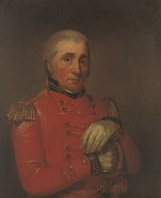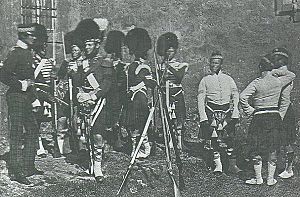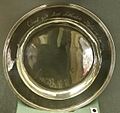93rd (Sutherland Highlanders) Regiment of Foot facts for kids
Quick facts for kids 93rd Regiment of Foot |
|
|---|---|
| Active | 1799–1881 |
| Country | |
| Branch | |
| Type | Infantry |
| Size | One battalion (two battalions 1813–1816) |
| Garrison/HQ | Castlehill Barracks, Aberdeen |
| March | The Thin Red Line Highland Laddie The Campbell March |
| Engagements | Napoleonic Wars War of 1812 Crimean War Indian Rebellion |
The 93rd (Sutherland Highlanders) Regiment of Foot was a famous foot soldier group in the British Army. It was started in 1799. This regiment was known for its brave soldiers, especially the Highlanders from Scotland. Later, in 1881, it joined with another regiment to become the Argyll and Sutherland Highlanders.
Contents
A Look Back: History of the 93rd Regiment
How the Regiment Started
The 93rd Regiment was formed on April 16, 1799. It was created by Major-General William Wemyss for the Countess of Sutherland. The soldiers were mostly from the Sutherland Fencibles. They were called the 93rd (Highland) Regiment of Foot.
The first time all the soldiers gathered was in August 1800. This happened in a place called Skail in Strathnaver. One soldier, Sergeant Samuel Macdonald, was very tall, standing six feet ten inches! The Countess of Sutherland was so impressed that she gave him extra money. She said someone so large needed more food than regular army pay allowed.
Unlike many soldiers of that time, who were often from tough backgrounds, the Highlanders of the 93rd were special. They were described as "children of respectable farmers." They were often related or knew each other well, like a big family. This made them a very disciplined and well-behaved group. One company even went 19 years without a single soldier being punished!
Fighting in the Napoleonic Wars
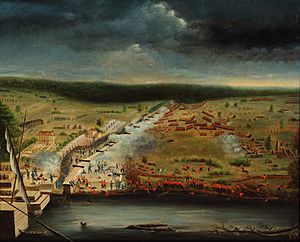
In September 1800, the regiment was sent to Guernsey. They returned to Scotland in 1802. In 1803, they went to Dublin to help stop a rebellion.
In 1805, they were supposed to go to Jamaica. But their orders changed, and they sailed to the Cape of Good Hope instead. They arrived in January 1806 and helped capture Cape Colony from the Dutch. They stayed there until 1814.
A second group, called the 2nd Battalion, was formed in 1813. This group went to Newfoundland in 1814. But they returned home and were disbanded in 1816.
Meanwhile, the 1st Battalion went to North America in September 1814. They fought in the War of 1812. They sailed to the Gulf of Mexico and moved towards New Orleans. They fought in the famous Battle of New Orleans in January 1815.
During this battle, the 93rd Regiment faced heavy fire. Their commanding officer was killed. Without clear orders, the regiment stood their ground and suffered many losses. Eventually, they were ordered to pull back.
After the battle, the 1st Battalion sailed back home. They arrived in Cork, Ireland, in May 1815.
Serving in Canada
In November 1823, the regiment went to the West Indies. They were based in Barbados, Antigua, and Saint Kitts. They returned home in 1834. The Duke of Wellington, a famous British general, gave them new flags in October 1834.
In 1838, the regiment was sent to Canada to help with the Patriot War. They landed in Halifax, Nova Scotia and fought in the Battle of the Windmill in November 1838. They stayed in Canada for ten years, returning home in August 1848.
The Crimean War: The Thin Red Line
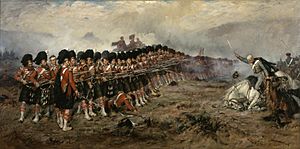
In February 1854, the regiment went to the Crimea to fight in the Crimean War. They were part of the Highland Brigade. They fought bravely in the Battle of Alma in September 1854.
On October 25, 1854, they were defending the port of Balaklava. A large Russian force attacked. The 93rd Regiment was a very small defense line. Their commander, Brigadier-General Colin Campbell, told them: "There is no retreat from here, men...you must die where you stand." A soldier named John Scott replied, "Aye, Sir Colin. An needs be, we'll do that."
Because of their bravery in holding their ground against a much larger force, the regiment earned its famous nickname: "The Thin Red Line".
The regiment also took part in the Siege of Sevastopol in 1855. They returned home in June 1856.
The Indian Rebellion
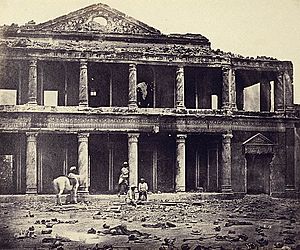
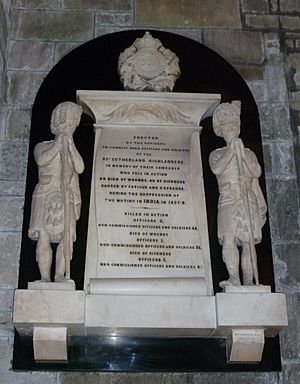
In June 1857, the regiment sailed to India to help stop the Indian Rebellion. They arrived in Calcutta in September 1857.
On November 16, 1857, the regiment, along with another group, bravely stormed and captured Sikandar Bagh. This was a strong, walled fort. Six Victoria Crosses, the highest award for bravery, were given to members of the regiment for their actions here. The next day, the regiment's flag was raised on a tower. This was a signal to other British forces that help had arrived. The regiment also helped protect the evacuation of a besieged area.
They fought again at the Second Battle of Cawnpore in December 1857. In March 1858, they helped capture Kaiser Bagh. Lieutenant William McBean earned a Victoria Cross for his bravery in this fight. The regiment also helped capture the city of Bareilly in May 1858.
In 1861, the regiment was officially renamed the 93rd (Sutherland Highlanders) Regiment of Foot. They returned home in 1870. They received new flags in 1871. Later, they moved to Ireland and then to Gibraltar.
Joining Forces: Amalgamation
In 1881, as part of army changes, the 93rd Regiment joined with the 91st (Argyllshire Highlanders) Regiment of Foot. Together, they formed the Argyll and Sutherland Highlanders. This marked the end of the 93rd Regiment as a separate unit.
Regimental Religious Traditions
The 93rd Regiment of Foot was known for being very religious. It was like its own church community within the army. Soldiers elected their own ministers and elders from among themselves. Two sergeants, two corporals, and two privates were chosen as elders. It was also said to be the only regiment with its own special communion plate for religious services.
Images for kids
-
Stone cross from the church at Kadikoi: The church was situated above the harbour at Balaklava and was the location chosen by Surgeon William Munro of the 93rd to establish a hospital. As a medical facility, it was admired for the general state of its cleanliness and efficiency, a testament to Munro’s knowledge of medicine and medical practices. This photograph from the 1850s which shows the church, tents and wooden huts nearby.
-
Silver Communion Plate and Chalce, inscibed "Church 93rd Regt Sutherland Highlanders, Cape1813". Both pieces were purchased in South Africa by the ordinary soldiers of the 93rd. They were used during the Communion service to distribute bread and wine. Originally the chalice had a lid but this was lost during the Second World War. Both the plate and chalice were continued to be used by the Regiment up until the late 20th century when copies were made and the original communion set given over to The Argyll and Sutherland Highlanders Regimental Museum. The copies were then used during Regimental Kirk service.
Battle Honours: What They Fought For
Battle honours are special awards given to regiments for their bravery in battles. The 93rd Regiment earned these honours:
- Cape of Good Hope 1806
- Crimean War: Alma, Balaklava, Sevastopol
- Indian Mutiny: Lucknow
Victoria Cross Heroes
The Victoria Cross is the highest military award for bravery in the United Kingdom. Several members of the 93rd Regiment earned this honour:
- Lance Corporal John Dunlay, Indian Mutiny (November 16, 1857)
- Private Peter Grant, Indian Mutiny (November 16, 1857)
- Private David MacKay, Indian Mutiny (November 16, 1857)
- Lieutenant William McBean, Indian Mutiny (March 11, 1858)
- Colour Sergeant James Munro, Indian Mutiny (November 16, 1857)
- Sergeant John Paton, Indian Mutiny (November 16, 1857)
- Captain William George Drummond Stewart, Indian Mutiny (November 16, 1857)
See also
- Argyll and Sutherland Highlanders
- Order of battle for the Balaclava campaign
- 93rd Highland Regiment F.C.


